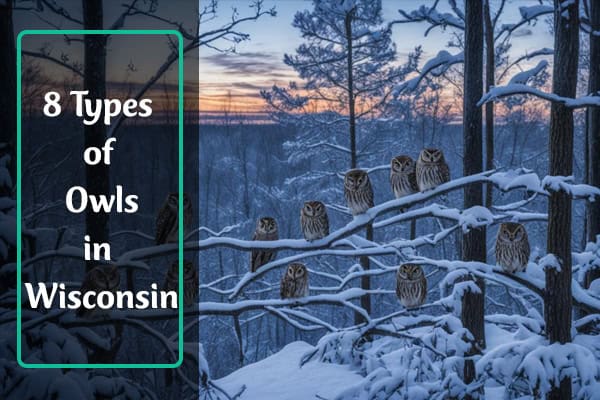Small Birds With White Stripes On Wings (ID Guide)
Here, we’ll discuss the Small Birds With White Stripes On Wings. Did you know the Slate-colored Junco is found from Alaska to Newfoundland? It has white stripes. On the other hand, the White-winged Junco is rare. It lives mainly in the Black Hills of South Dakota and Wyoming.
We are excited to share more about these small birds, which have white stripes on their wings. This guide is for both birdwatchers and newcomers.
We will examine different species, discuss their unique features, and explain why their wing markings are important. Let’s explore the skies together and see these amazing birds!
Introduction to Small Birds with White Stripes
Exploring small birds with white stripes on their wings is a joy. These birds, like the White-crowned Sparrow, have unique markings that make them easy to spot.
Their color patterns are not just pretty. They help attract mates and warn off predators too.
These birds live in many places, from forests to urban parks. With a bird-watching guide, we can find them. Watching them hop low among the brush shows us their daily lives.
Learning about these birds makes spotting them easier. For example, White-crowned Sparrows have black-and-white stripes and pale bills. Knowing these details makes bird-watching more fun and helps us appreciate nature more.
Recognizing Bird Species with White Stripes
Looking for bird species with white stripes is fun for bird fans and nature lovers. Knowing their common traits helps us see their beauty. The special wing markings help us tell different species apart.
Common Characteristics
White-striped winged birds have unique features. Size, color, and where they live help us identify them. For example, the Lesser Nighthawk has a white bar on its wings.
Females have a smaller cream-colored band. These birds often blend in with their surroundings. They can be small, like the Black-and-white Warbler, or big, like the Lark Bunting.
Significance of Wing Markings
The wing markings of bird species with white stripes are very important. They help these birds hide from predators and help us tell different birds apart.
For instance, the Lesser Nighthawk’s white bands are easy to see when it flies. Knowing about these markings helps us learn more about these beautiful birds.
| Species | Size | Locality | Status | Breeding Season |
|---|---|---|---|---|
| Lesser Nighthawk | Intermediate-size | Deserts, open country, scrubby areas | Least Concern | Various times of the year |
| Lark Bunting | 14 to 18 cm (5.5 to 7.1 in) | Central and western North America | Least Concern | May to June |
| White-winged Chough | 45 cm (18 in) | Southern and eastern Australia | Least Concern | August to December |
| Black-and-white Warbler | 12 cm (5 in) | Northern and Eastern North America | Least Concern | April to August |
1. Lesser Nighthawk
The lesser nighthawk is a small bird with white stripes on its wings. It’s easy to spot because of its unique looks and actions. Knowing how to identify it makes bird-watching more fun, especially when we see it in nature.

Appearance and Size
The lesser nighthawk has long wings and white tips. Males have a big white bar on their wings, while females have a smaller cream-colored band. It’s about the size of a small sparrow, weighing 1.6 to 1.8 ounces.
It’s bigger than violet-green swallows but smaller than barn owls. Its wingspan is around 21.6 inches, making it look elegant when it flies.
Behavior and Habitat
The lesser nighthawk is special because of how it acts. It stays still during the day, blending in with the ground. But at dusk and dawn, it comes to life, catching insects in mid-air.
These birds live in different places, from cities in the southwest to open lands. They move to warmer places in winter, showing they’re not full migrants.
2. Black-and-White Warbler
The black-and-white warbler is a favorite among bird watchers. Its striking looks and lively behavior make it fun to watch, and knowing its unique features helps us better enjoy this bird.

Distinctive Stripes and Patterns
The black-and-white warbler is about 12 centimeters long and has bold black-and-white stripes that make it easy to spot. Adult males have more streaks, while females are paler and have a buffy appearance on their sides.
This bird is part of the Mniotilta genus. Its colors are a beautiful sight in its breeding areas. These areas stretch from Canada to the east coast of the United States.
Foraging Behavior
The black-and-white warbler forages like nuthatches. In summer, they forage at eye level, making them easy to see. We see them moving on tree trunks and branches, looking for insects.
They also respond to pishing, helping us spot them more easily.
Preferred Habitat
In summer, these warblers love large deciduous or mixed forests. They nest on the ground, hidden by trees, rocks, or logs, which helps them blend in.
In winter, they move to Florida, Central America, and northern Peru, making them a joy to watch in different places.
Understanding the Color Patterns of White Striped Winged Birds
It’s really interesting to look at white-striped-winged birds. We see big differences between males and females, which help us tell birds apart and show their roles in nature.
Variations in Male and Female Birds
Many birds have males with bright colors and clear patterns. Females are usually less colorful. This helps males attract mates and females hide from predators.
- Male Characteristics: Often possess brighter colors and pronounced stripe patterns.
- Female Characteristics: Typically have subtler hues that provide camouflage.
Knowing these differences makes bird watching more fun. The colors on these birds are not just pretty. They help the birds survive and have babies. By learning about these differences, we can better enjoy watching birds and know them better.
Small Birds Identification Techniques
Identifying small birds is fun for birdwatchers. We can improve by using different methods and tools. These help us spot species easily and enjoy the process more. Field guides and mobile apps are great for this.
Field Guide Recommendations
Field guides are key for bird watching. They show pictures and give details to help us tell species apart. For birds with white stripes on their wings, here are some top field guides:
- The Sibley Guide to Birds – Shows over 600 species with clear images.
- Peterson Field Guide to Birds of North America – Gives detailed descriptions and behaviors.
- National Geographic Field Guide to the Birds of North America – Has many species and beautiful photos.
Utilizing Mobile Apps for Bird Watching
Mobile apps make bird watching better. They let us track birds and learn about them on our phones. Here are some good apps:
- Merlin Bird ID – Great for beginners, it helps with identifying birds.
- eBird – A project where users share bird sightings and see trends.
- BirdNET – Uses sound to identify birds, helping us listen better.
Bird Watching Guide for Beginners
Starting in bird watching? The right gear makes it better. Knowing what to bring helps us enjoy white-winged birds more. Our guide will cover the basics and where to find these birds.
Essential Gear for Bird Watching
For a great bird-watching trip, you need the right tools. Here’s what you should have:
- Binoculars: Good binoculars let you see birds from far away. They help spot details like special markings.
- Field Guides: Guides like The Sibley Guide to Birds or apps like Merlin Bird ID are key. They tell us about North American birds.
- Notepad and Pen: Writing down what you see helps you learn. It’s also a personal journal.
- Comfortable Clothing: Wear clothes that fit the weather. It makes your trip more enjoyable.
Top Locations to Spot Striped Winged Birds
Looking in different places helps find white-winged birds. Here are some top spots in the U.S.:
- Central Park, New York: It’s great for city bird watching. You can see many species in one place.
- Everglades, Florida: It’s full of birds in wetlands and by the coast.
- Point Reyes National Seashore, California: It has amazing views and migrating birds.
- Great Smoky Mountains, Tennessee/North Carolina: This area is perfect for birders, with many habitats and species.
Using our guide and visiting these places will make bird watching better. Spotting and identifying white-winged birds is fun and rewarding. Remember, being patient and practicing helps get better.
Rare Birds with Striped Wings
We find unique species in our search for rare birds with striped wings. These birds are not just beautiful but also key to nature’s balance. By learning about them, we help protect these special creatures.
Identifying Rare Avian Species
For birdwatchers, seeing rare birds with striped wings is exciting. Many have special traits that help us identify them. For instance, the White-crowned Sparrow has striking wing patterns.
They often lay three to seven eggs, showing their breeding habits. Knowing where they live helps us understand their survival strategies.
Conservation Efforts for Striped Winged Birds
Protecting birds like the White-crowned Sparrow is crucial. Groups work hard to save these birds. They focus on keeping their habitats safe and teaching people about their importance.
By joining local wildlife efforts, we help these birds, allowing them to live and thrive for many years.
How to Attract White-Winged Bird Species
Learning how to attract white-winged bird species can improve birdwatching. These colorful doves, like the White-winged Dove, need the right food and places to nest. With a few simple steps, we can make our yards welcoming.
- Provide Suitable Feeders: Offering seeds, especially grains like milo, can draw white-winged doves. They like to forage, so put feeders where they can easily reach them.
- Plant Native Flowers: Adding native plants to our gardens attracts white-winged species. These plants also provide food, such as berries and nectar.
- Create Safe Nesting Areas: Make sure there are dense shrubs and trees for nesting. White-winged Doves like to nest in places with cover, like thorny bushes.
- Incorporate Birdbaths: Water is key. Birdbaths or shallow water dishes encourage white-winged doves to visit and stay in our yards.
Knowing what they like helps us attract these beautiful birds. White-winged Doves are flexible, living in both cities and nature. We can enjoy watching these doves and help them stay in our areas.
Importance of White Striped Birds in Ecosystems
White-striped birds, like the White-crowned Sparrow, are very important. They help keep our environment healthy and play key roles in pollination and pest control.
Role in Pollination and Insect Control
These birds help control insect numbers by eating them, reducing the need for harmful pesticides. They also help plants grow by pollinating them.
Here’s a closer look at some statistics related to the White-crowned Sparrow and its ecological system:
| Aspect | Details |
|---|---|
| Population Decline | Declined by about 29% between 1966 and 2012 |
| Breeding Habitats | 67% breed in boreal forests of northern U.S. and Canada |
| Subspecies | Four recognized, varying in appearance and behavior |
| Broods per Season | Northern subspecies raise one brood; southern can raise up to four |
| Pesticide Effects | Neonicotinoid pesticides can harm their migration and health |
| Adaptive Behavior | Quickly adjust to changing soundscapes, benefiting urban populations |
| Conservation Needs | Efforts to protect nesting and wintering habitats are crucial |
White-striped birds are more than just birds. They show us how healthy our ecosystems are. By learning about them, we can help protect these important birds.
Conclusion
Our look at small birds with white stripes on their wings has shown their unique traits and role in nature. These birds add beauty to our world and help keep ecosystems balanced. They are key to biodiversity.
By watching and learning about these birds, we connect more with nature. We see how all living things depend on each other, and this understanding is important.
We urge everyone to watch birds and learn about them. Our help is needed to keep their homes safe. Small actions, like supporting conservation, make a big difference.
Our love for birds can teach us to help protect them. This way, future generations can also enjoy their beauty. Let’s work together to save these special birds.
Read more🐦Related Articles:
| Small Birds With Orange Beaks |
| Small birds With White Tails |
| Finches in the UK |
| Common UK Birds |
| Eagles in the UK |
Frequently Asked Questions
Q1. What bird has white stripes on its wings?
Many birds, such as the American Goldfinch and Northern Mockingbird, have white wing stripes as distinctive features.
Q2. How do you identify small birds with white wing stripes?
Look for the bird’s size, shape, and color patterns, focusing on the white wing bars against darker-colored wings. Observe the bird’s behavior and habitat.
Q3. Which small birds have white markings on their wings?
Species like the Black-capped Chickadee and Pine Warbler are small birds known for their white wing markings.
Q4. What species of birds have white wing bars?
Birds like the Blue Jay and Red-winged Blackbird commonly feature white wing bars.
Q5. Why do some birds have white stripes on their wings?
White stripes help birds in flight identification, courtship displays, and sometimes act as camouflage or signals to other birds.
Q6. Are white-winged birds common in North America?
Yes, several common North American birds, including the Downy Woodpecker and Dark-eyed Junco, have white wing patches.
Q7. What are the most common birds with white wing patches?
The Northern Flicker, White-crowned Sparrow, and Tree Swallow are among the most common birds with noticeable white wing patches.
Q8. How to spot birds with white-striped wings in my backyard?
To spot them, set up feeders, provide water, and observe closely for small birds like chickadees and sparrows with distinct white markings on their wings.







